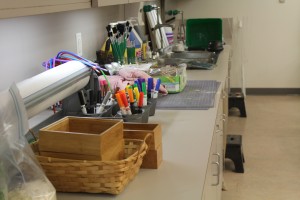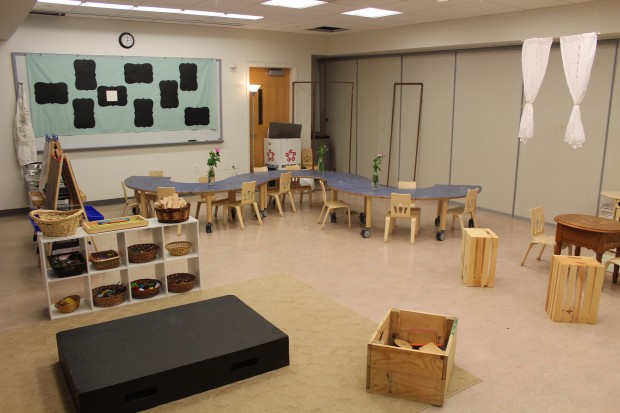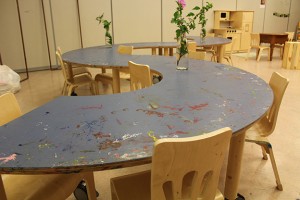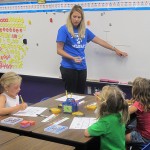Museums Face Access, Quality Challenges With Educational Programs
The options for Indiana’s youngest learners are expanding every day.
The hunger for preschool across Indiana continues to grow, fueled by initiatives like the state’s On My Way Pre-K pilot program and Indianapolis Mayor Greg Ballard’s Indy Preschool Scholarship Program, both initiatives targeted toward low-income families.
Momentum is so great that programs are popping up in places you might not otherwise expect them – like the Indianapolis Museum of Art. The IMA has offered summer classes and supplemental educational programming for years, but this is the first time it is hosting a group of young children for a year-long classroom experience. And like many of these other institutions, the IMA has a lot to consider in starting this type of educational program.
- Reading, Writing, Arithmetic...and ArtThe hunger for preschool across Indiana continues to grow, fueled by initiatives like the state’s On My Way Pre-K pilot program and Indianapolis Mayor Greg Ballard’s Indy Preschool Scholarship Program. Both initiatives are targeted toward low-income families. Momentum is so great that programs are popping up in places you might not otherwise expect them – like the Indianapolis Museum of Art. StateImpact Indiana’s Rachel Morello paid the museum a visit to learn the specifics of the pre k program and see the challenges a museum faces in offering education programming.Download
‘The arts is a great natural fit’
Children and adults alike have had opportunities to experience the IMA beyond its galleries and exhibits for years. The museum offers an array of courses ranging from creative indoor workshops to interactive adventure sessions at one of its many garden and outdoor facilities.
There is also plenty of programming for school groups, who often schedule their own field trips to the museum. Heidi Davis-Soylu, the IMA’s manager of academic engagement and learning research, noticed that one such local group took frequent advantage of these events, and decided it was worth forging a partnership.

Art supplies line the countertop in a preschool classroom at the Indianapolis Museum of Art. (Photo Credit: Rachel Morello/StateImpact Indiana)
A toddler art program came out of that collaboration with St. Mary’s Child Center, which expanded and evolved into what has now become the IMA preschool.
“We learned a lot about working with toddlers in the art galleries – what’s the good ratio? How do we make this a space where they feel like they belong, but they also know how to be quiet in the hallways if we need to?” Davis-Soylu explains. “Bringing in the arts is a great natural fit for early childhood education.”
So beginning this week, just as the museum is opening to the public, a gaggle of three- and four-year-olds is leaving the building at the end of their school day. This group of seven makes up the IMA’s very first preschool class.
“As the largest art institution in the state and as in schools cutbacks are happening for art education are happening, we’re charged with that task to play that role,” Davis-Soylu says.
The program is based on principles of the Reggio Emilia approach, an educational philosophy that emphasizes self-guided learning. Similar movements, such as the Montessori method, exist and are practiced at other museum preschools – including the Children’s Museum of Indianapolis. Davis-Soylu says there’s plenty of research touting the benefits of the object-based learning a museum can provide, especially at an early age.
“The teacher is a researcher who is constantly following the children and deciding what the next thing will be according to what the interest is,” Davis-Soylu explains, offering gallery visits or work in the museum’s orchard as options the children might choose to explore. “The IMA is really the backdrop, and the learning will happen.”
Challenge #1: Expanding Access
The IMA moved up its program’s 2016 start date to this year, inspired by energy circling the state for new initiatives like On My Way Pre-K pilot (for which Marion County is a participant) and Indy PSP.
“It’s really important that the IMA is part of that vision and immediately part of that action that’s happening now with the vouchers and the support for early childhood, particularly for the children who are most at need and most at-risk,” Davis-Soylu says.
The challenge will be reaching families who could benefit.

The preschool classroom inside the Indianapolis Museum of Art. (Photo Credit: Rachel Morello/StateImpact Indiana)
Elizabeth Merritt is the director of the Center for the Future of Museums, an initiative of the American Alliance of Museums. She says the IMA faces a challenge common among museums that attempt to run educational programs: their natural audience for in-house programming is the people who have memberships at and frequent the museum. And the demographics of that group don’t always match the audience they’re trying to reach.
“I think the museum’s great challenge is in being as accessible as possible, about having no real or perceived barriers to who can benefit from that kind of learning,” Merritt says.
“We don’t want it to be just another elite structure layered on the existing system,” she continues. “It can’t be something that’s just another equivalent of being able to afford a private school, or having the capacity to figure out how to get your kid into a really good charter school. It needs to help level the playing field, not add to inequities.”
There’s evidence that the IMA is moving in the direction of including a more diverse audience. The museum in general offers some of its programming to the public for free, and the preschool team will attempt to include those families who might not otherwise be able to participate.
The goal is to gain enough additional partners by next fall to be able to fund scholarships for half of the children who participate. Davis-Soylu says her team will consider trying to extend the half-day program to host children for a full day, which would also qualify it to participate in one of the existing programs.
“We are doing everything that we need to do this year so that we’ll be eligible for those vouchers and that system for next year,” she says.
Challenge #2: Ensuring Quality
Another challenge: making sure the museum can offer a high-quality option. That’s a primary focus in Indiana right now; in order to qualify for On My Way Pre-K, providers must either have proper accreditation or attain a Level 3 or 4 status on the state’s Paths to QUALITY ranking system.
—Ted Maple, President and CEO, Early Learning Indiana
“The more programs we have focused on quality going above and beyond just what’s required of them, the better,” says Early Learning Indiana President and CEO Ted Maple. “If the program meets the standards that we know are good for children, then children will have a great experience and will see the educational and social outcomes that go along with those experiences.”
Maple says the fact that the IMA is working in partnership with St. Mary’s Child Center to provide administration and oversight is a promising step to ensuring quality. St. Mary’s is also in charge of hiring and training teachers.
“If you’re starting a new program, it certainly helps to have a partner that knows the business, that knows the landscape and knows how to operate a high-quality program,” Maple says.
Luckily, there’s another successful model the IMA can look to for guidance just a few miles away: the Children’s Museum of Indianapolis has been operating a preschool program of its own for five years now. It enrolls more than 100 kids in half-day sessions and families come from as far as Lafayette to participate.
Children’s Museum Preschool Director Cathy Southerland was one of Davis-Soylu’s first calls when the IMA decided to start a preschool. She advises taking advantage of what makes their program different: incorporating all the museum has to offer into a child’s day-to-day learning.
“We tie most of our curriculum in with whatever is happening in the museum,” Southerland says. “Essentially, it places the museum as their classroom. They truly have the world’s biggest classroom at their fingertips.”
—Cathy Southerland, Director, Children’s Museum Preschool
Teacher Anna Root agrees. She adds that her four years at the Children’s Museum Preschool have been extraordinarily different from a previous experience teaching in a public preschool.
“I think that one of the main differences is maybe our philosophies and kind of our environments,” Root says. “Not only are we in a museum, but also our classrooms are reflective of museum culture and our philosophies with natural materials – not bright colored bulletin boards on the walls, or bright colored boxes and containers. We use baskets and we use glass materials, and we really teach our students how to use those things and what it means to respect them.”
The Way of the Future?
Are museums the future for schools?
Elizabeth Merritt thinks so.
“We’re seeing a shift in how we structure learning and what it means to be a school,” Merritt says. “A lot of the things they’re saying about the next era of education – that it’s going to be hands-on, experiential, immersive, passion-based – are exactly the kinds of learning experiences that take place in museums.”

Seven students are currently enrolled in the preschool program at the Indianapolis Museum of Art. (Photo Credit: Rachel Morello/StateImpact Indiana)
In a foreword for a report Merritt’s organization put out late last year, Michael Robbins, senior advisor for nonprofit partnerships at the U.S. Department of Education, said schools should not have to – and cannot – do it alone.
“Students know that schools are only one node in their broader network of learning, and our education structures should reflect this reality,” Robbins wrote. “Working together, schools and museums can design learning experiences that are engineered from the student perspective and create a better future for education.”
The IMA students haven’t been in the museum galleries yet, but Davis-Soylu says the plan is to head there by the end of this first week. She says she’s looking forward to having the added energy in the building every day.
“It’s great to see children running on the lawn and using the spaces. I think it’s going to be great for everybody,” she says with a smile.
There is still room to grow – Davis-Soylu says she’s keeping enrollment open and already has two more requests sitting in her inbox, so she’s hopeful the IMA can work its way onto the radar in Indy’s preschool landscape.
Podcast: Play in new window | Download
